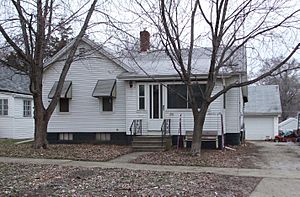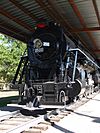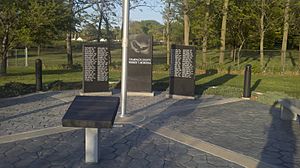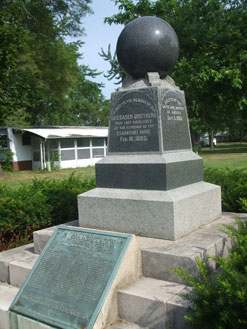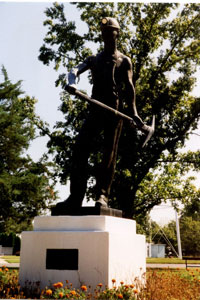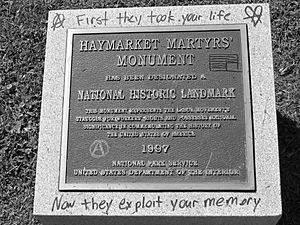List of historical sites related to the Illinois labor movement facts for kids
The following are important moments in the history of workers in Illinois:
Illinois has a rich history of workers fighting for their rights and better conditions. Many places across the state remember important events and people from this past. These sites help us learn about the struggles and successes of working people in Illinois.
Important Places in Illinois Labor History
Downstate Illinois Labor History Sites
Beckemeyer Coal Miners Monument: Remembering a Mine Disaster
This monument honors Joseph Koch and eight other local miners who died in the 1947 Centralia mine disaster. A plaque explains the sad event.
On March 25, 1947, a huge explosion happened at the Centralia Coal Company Mine No. 5 in Wamac, Illinois. By March 29, it was clear that the explosion and poisonous gas had killed 111 of the 142 men working in the mine.
This statue remembers Joseph Koch Sr. and the other miners from Beckemeyer who lost their lives.
Belleville Labor and Industry Museum: A Look at Work History
This museum is in an old cigar factory in Belleville, Illinois. It has many photos, documents, and inventions related to work and industry in the city. The museum is open on Saturdays.
George Franklin Bilyeu Monument: A Miner's Sacrifice
Located in Taylorville, Illinois, this monument remembers George Franklin Bilyeu (1854–1898). He was killed in Virden, Illinois, in 1898 during a fight between the United Mine Workers of America and armed guards. The guards were bringing in workers to break a strike at the Virden mine.
Bloomington Workers' Memorial Monument: Honoring Workers
This monument is in White Oak Park. The park has 100 trees donated by unions to honor local workers who died from work-related accidents or illnesses. It also has a large flagpole, moved by unions in 1996. The flagpole was made in 1942 by Chicago & Alton Railroad Shops workers to show patriotism during wartime.
The Bloomington Normal Trades & Labor Assembly holds a ceremony here every Workers' Memorial Day on April 28.
Bloomington Labor History Mural: Stories on a Wall
A large mural, 12 feet tall and 18 feet wide, shows local labor history inside the Laborers Local 362's old hall in Bloomington, Illinois. The mural shows events like the Chicago & Alton Railroad shops and the 1922 Shops workers' strike. It also depicts a 1917 visit by Mary Harris "Mother" Jones supporting striking streetcar workers.
Bloomington & Normal Bike Trails: History on the Go
Bloomington and Normal have many bike trails, often on old railroad paths. Some trails have historic markers about local industries and neighborhoods. The "Constitution Trail" has ten markers. This trail follows an old Illinois Central railroad path from the 1850s.
Markers on this trail tell about the railroad's building and a restored wooden bridge. Another trail in Bloomington follows an old Peoria & Eastern railroad path. It has markers about the local meat packing industry and a 1917 streetcar strike. Mary Harris "Mother" Jones was involved in that strike.
Bloomington's Labor Leaders: Champions for Workers
Patrick H. Morrissey: A Railroad Union Leader
Patrick H. Morrissey (1862–1916) led the Brotherhood of Railroad Trainmen from 1895 to 1909. He grew up near the railroad yards in Bloomington. Morrissey worked as a "call boy" during school, summoning railroaders for their shifts. After graduating high school, he worked for the railroad as a clerk, brakeman, and conductor.
In 1885, Bloomington workers formed a union lodge, and Morrissey was a founding member. He quickly became important in the union, helping it grow and become financially strong. He united with the Order of Railway Conductors to negotiate better deals with railroads. When Morrissey left the union in 1909, it had 120,000 members and millions of dollars in funds.
Daniel W. Tracy: Electrical Workers' President
Daniel W. Tracy (1886–1954) was another Bloomington native who became a national union leader. He became president of the International Brotherhood of Electrical Workers (IBEW). Tracy started working for street railways as an electrician.
He joined IBEW in 1913 and quickly rose through the ranks. In 1933, during the Great Depression, Tracy became the union's national leader. Under his leadership, the IBEW grew from 50,000 members to 200,000 by 1940. He supported President Franklin D. Roosevelt and later served as Assistant Secretary of Labor. He returned to lead the IBEW again in 1947, helping it grow to 360,000 members.
John Brown Lennon: A Tailor's Union Pioneer
John Brown Lennon (1850–1923) was a very important labor leader in Bloomington. He learned the tailor's trade from his father. Lennon became active in the Journeyman Tailors Union (JTU) and was elected general secretary in 1886. He moved the union's headquarters to Bloomington in 1896.
Lennon also became the treasurer of the American Federation of Labor (AFL) in 1890. He was a close friend of AFL President Samuel Gompers. Lennon worked to strengthen unions and promote union-made products. He was known for his strong views, including supporting the temperance movement, which meant he was against alcohol.
Lennon lost his union position in 1910 but remained influential. He was appointed by President Woodrow Wilson to a board of mediators during World War I. He ran for mayor of Bloomington in 1919 and nearly won.
Centralia Fairview Park: Railroad Heritage
In Centralia's Fairview Park, there are two memorials to the area's railroad history. Locomotive 2500 is a large Illinois Central Railroad steam engine. Centralia had big shops for repairing and building trains. Next to the locomotive is a tablet honoring railroad engineer Robert I. "Polecat" McMillan. He retired in 1956 after 67 years of railroad service, at age 83, making him the oldest locomotive engineer in the U.S.
Chicago & Alton Railroad Shops Site: A Hub of Work
Once, Bloomington was a major center for railroad repair and construction by the Chicago and Alton Railroad. This was because it was halfway between Chicago and St. Louis. Here, locomotives and train cars were fixed and built. This railroad shop was once the largest employer in McLean County.
The shops needed many skilled workers: boilermakers, machinists, woodworkers, and more. At their busiest, in the early 1900s, almost 1,200 people worked here. The shops faced fires and threats to move, but the community always helped rebuild them.
In 1917, 1,200 workers from the shops went on a sympathy strike to support workers in the 1917 Bloomington Streetcar Strike. In 1922, workers joined a national railroad strike, and the Illinois National Guard was called in. The shops closed in the late 1970s.
Champaign County Workers' Memorial Monument: Remembering Those Lost
This memorial is in Dodds Park in Champaign, Illinois. It has three large black stone tablets. Two of them have the names of people who died on the job in Champaign County since 1950. The memorial was dedicated on September 2, 2002.
Decatur Workers' Memorial Monument: A Call for Safety
Located at the Macon County Courthouse in Decatur, Illinois, this monument honors workers who died from work-related accidents or illnesses. It reminds everyone to keep fighting for safe workplaces. The Decatur Trades & Labor Assembly built it, and it was dedicated in 2000. A ceremony is held here every Workers' Memorial Day on April 28.
Chatham Railroad Museum: Preserving Train History
This museum is in the old Chicago & Alton Railroad Depot in Chatham, Illinois. It has a collection of railroad books, photos, and equipment. The museum is open on the second and fourth Sundays of each month.
Cherry Mine Disaster Site: A Tragic Fire
A historical marker in Cherry Village Park remembers the 1909 Cherry Mine disaster. In this terrible event, 259 miners died, making it one of the worst mine disasters in U.S. history. The fire started from hay used for mules in the mine and spread quickly.
This disaster led to new, stricter mine safety rules and the Illinois Workmen's Compensation Act, which helped injured workers. There are memorials in the cemetery and next to the library, listing the names of the miners who died.
The Coal Miner: Honoring Miners' Sacrifices
This statue is on the grounds of the state capitol in Springfield. It honors miners who died on the job in Illinois. A coal miner, Vachel Davis, helped get money for the statue. He worked with sculptor John Szaton to create the 7-foot bronze figure. It was dedicated on October 16, 1964.
Coal Miners' Memorial: Remembering a West Frankfort Tragedy
This memorial in West Frankfort, Illinois, honors all coal miners. On December 21, 1951, a methane gas explosion caused a fire in the New Orient Mine No. 2, killing 119 miners. The blast was so strong it knocked heavy train cars off their tracks.
Coal Miners' Memorial Monument: Panama's Tribute
This 10-foot tall monument in Union Cemetery in Panama, Illinois, is made of black marble. It has a picture of an early coal miner and a quote from John L. Lewis, a famous union president who lived in Panama. It especially remembers six miners who died in a 1915 gas explosion in the Panama mine.
Diamond Mine Disaster Site: A Mine Collapse
This historical marker is in Diamond Park in Diamond, Illinois. On February 16, 1883, part of the mine collapsed due to melting snow and heavy rains. Many men and boys, some as young as 13, were killed. The mine was later sealed with 46 miners still inside.
First Coal Mine: Illinois' Mining Start
An old historical marker (now gone) near Murphysboro, Illinois, remembered the first commercial coal mining in Illinois. Coal was dug from the Big Muddy River bluffs. As early as 1810, coal from here was sent by boat to New Orleans.
Zeigler Coal Miners' Memorial: A Town's Tribute
In the main square of Zeigler, Illinois, there is a Miners Memorial with a statue built in 1974.
Granite City Steel Mill: A Long History of Steel and Unions
This steel mill is likely the longest-running steel mill of its kind in the Western Hemisphere. It started in 1878. It might also be the longest continuously unionized steel mill. Local unions merged in 2003 to form Local 1899, choosing the number because a labor agreement has existed since 1899.
The United Steelworkers union represents most of the 2000+ workers. The plant has operated almost continuously since 1878.
Illinois Department of Corrections Memorial: Honoring Prison Workers
A memorial wall at the Pontiac Correctional Center in Pontiac, Illinois, honors Illinois Department of Corrections workers who died on the job. It was dedicated on May 9, 2002.
Illinois Firefighters' Memorial: Heroes Remembered
Located at the State Capitol building in Springfield, Illinois, this memorial honors firefighters who died while on duty. It was dedicated on May 13, 1999. The memorial has four life-size bronze firefighters and a rescued child on a stone pile. A ceremony is held here each May.
Illinois Workers' Memorial: For All Workers
This memorial is also on the lawn of the State Capitol building in Springfield, Illinois. Paid for by union members, this 3,000-pound memorial remembers the thousands of Illinois workers killed and injured on the job. The bronze sculpture was dedicated on April 28, 1992.
Irish Railroad Workers' Monument: A Sad Story
This memorial is a 6-foot marble Celtic cross with writing in English and Gaelic. It marks a mass grave of 50 Irish immigrant railroad workers. They were buried without names in Funk's Grove cemetery, south of Bloomington, Illinois. These workers built a rail line in 1852 and likely died from a cholera epidemic. It was dedicated on Workers' Memorial Day, April 28, 2000.
Ironworkers' Memorial: A Bridge Tragedy
This polished granite memorial in Peoria, Illinois, honors three members of Ironworkers Local 112. They died when scaffolding collapsed while they were repairing the McClugage Bridge, causing them to fall 60 feet into the Illinois River. The memorial has a picture of the bridge and the workers' names.
Jacksonville Labor Temple: A Historic Union Building
The Labor Temple in Jacksonville, Illinois, might be the oldest standing building linked to organized labor in the United States. It is listed on the National Register of Historic Places. Built in 1904, it was a headquarters for labor unions for many years. After falling into disrepair, unions worked to buy and restore the building.
John L. Lewis Grave: A Union Legend
The grave of John L. Lewis (1880–1969) is in Oak Ridge Cemetery in Springfield, Illinois. Lewis was president of the United Mine Workers of America from 1920 to 1960. He also founded the Congress of Industrial Organizations (CIO) in 1935. Lewis worked as a coal miner in Illinois and Iowa.
Madison County Workers' Memorial: Honoring Local Workers
Located at the entrance to Gordon F. Moore Park in Alton, Illinois, this memorial is a life-size sculpture of a worker. It has granite wings with the names of men and women from Madison County who died on the job.
John Mitchell Marker: A Miner's Journey
Historical markers in Spring Valley, Illinois, remember John Mitchell. He was born in Braidwood, Illinois, in 1870 and started working in coal mines at age 12. He joined the United Mine Workers of America in 1890 and became its president from 1899 to 1908. He became famous for settling a big miners' strike in 1902.
Mother Jones Monument: A Champion for Workers
This monument, built in 1936, marks the grave of Mary Harris Jones ("Mother Jones", 1830–1930) in the Union Miners' Cemetery in Mount Olive, Illinois. The monument has a tall granite stone with Mother Jones's face and two bronze statues of coal miners. It is listed on the National Register of Historic Places.
Moweaqua Coal Mine Museum: Remembering a Gas Explosion
The museum in Moweaqua, Illinois, opened in 1985 to remember the 1932 Moweaqua Coal Mine disaster. In this event, a gas explosion killed 54 miners. Methane gas escaped and was ignited by open-flame carbide lights. After this, such lights were no longer used in mines. The museum has mining tools and stories from the disaster.
Normal Fire Fighters Strike: Fighting for a Contract
In 1978, firefighters in Normal went on strike for 56 days to win their first union contract. Illinois did not have a law for public employees to bargain collectively until the 1980s. The firefighters refused to enter the fire station but still provided fire service from the picket line.
The town got a court order, and the firefighters were sent to jail. They became known as "Local 24/42" because 24 firefighters were sentenced to 42 days in jail. This brought national attention to their strike. After their jail time, negotiations restarted, and they won a contract in May 1978.
Ottawa Radium Girls Monument: A Fight for Safety Laws
This 2011 statue in Ottawa remembers the "radium girls." These young women died from radiation poisoning in the 1920s and 1930s while painting clock dials with glowing paint. Their court case brought attention to the dangers and led to stricter laws about safety in factories.
Peoria Workers' Memorial: Honoring Union Members
This memorial is in front of the Peoria city hall in Peoria, Illinois. It was built by the West Central Illinois Labor Council to honor union members who died on the job.
Peoria Rocky Glen Park: Secret Union Meetings
In late 2012, the City of Peoria bought the Rocky Glen area. This rugged, wooded area has carvings on its limestone rocks. These carvings suggest that this was a secret meeting place for early mine workers' unions.
Railroad Workers' Monument: Remembering Train Builders
This monument, dedicated in 1982, is in Miller Park in Bloomington, Illinois. It remembers the workers who built and repaired railroad cars at the former Chicago & Alton Railroad Company shops in the city. The monument has a 6-foot tall whistle, which was used at the old shops to signal work times.
Next to the monument is a Nickel Plate Road steam locomotive 639. It was moved to the park in 1959 with help from union workers.
Seneca Shipyard Monument: Building Warships Inland
Located in Crotty Park in Seneca, Illinois, this monument honors the Landing Ship, Tank (LST). These were World War II naval landing vessels built in inland shipyards like Seneca. They were floated down the Illinois and Mississippi Rivers to New Orleans. Between 1942 and 1945, 157 LSTs were launched from Seneca, which had 11,000 workers.
Refinery History Museum: Fueling the Past
The museum in Roxana, Illinois, is in an old building used for testing cars and engines. It was started in 1993 by retired workers from the Shell Wood River Refining Company. It has items and memories from the company.
Reuben Soderstrom Statue: A Long-Serving Labor Leader
In City Park in Streator, Illinois, there is a statue of Reuben Soderstrom (1888–1970). He was an Illinois state representative and later became President of the Illinois AFL in 1930. He then led the combined Illinois AFL–CIO from 1958 until 1970.
Southern Illinois Coal Miners' Memorial: A Region's Tribute
This monument in the city park in Marissa, Illinois, has a stone slab with a coal miner etched into it. It honors the coal miners of Southern Illinois and was dedicated on August 1, 1921.
Union Miners' Cemetery: A Resting Place for Labor Heroes
Located in Mount Olive, Illinois, this cemetery was founded in 1899. It was originally for miners killed in the Battle of Virden in 1898. It holds the graves of Mary Harris "Mother" Jones and many coal miners. The cemetery is on the National Register of Historic Places.
Chicago Labor History Sites
Chicago Labor Mural – The Worker: Meatpacking Industry Story
This mural shows the history of workers and bosses in Chicago's meatpacking industry during the 20th century. It is on the outside of the former headquarters of the United Packinghouse Workers of America. The mural was created in 1974 by William Walker, known as the "father of the Chicago mural movement."
Chicago Labor Mural – Fabric of our Lives: Jewish Immigrant Culture
This ceramic and glass tile mosaic shows the life, work, and culture of Jewish immigrants in Chicago. It is 12 by 14 feet and was created in 1980 by Miriam Socoloff & Cynthia Weiss.
Cigar Makers' Union Monument: Honoring Cigar Makers
This monument in Forest Home Cemetery in Forest Park, Illinois, honors the Chicago cigar makers buried nearby.
Gompers Park, Chicago: Remembering a Union Founder
Gompers Park covers almost 39 acres in Chicago. A bronze statue by Susan Clinard remembers Samuel Gompers (1850–1924), a very important person in the American labor movement. Gompers started working as a cigar maker at age ten. He helped found the American Federation of Labor (AFL) and was its first and longest-serving president.
Graceland Cemetery: Famous Figures
This cemetery in Chicago is the burial place for many famous people. These include company founders like George Pullman and Philip D. Armour. Also buried here is Governor John Peter Altgeld, who pardoned some men convicted in the Haymarket bombing.
Margaret A. Haley Plaque: A Teacher Union Pioneer
A plaque honoring Margaret Haley is at the Chicago Teachers' Union headquarters. Margaret Haley was a pioneer in teacher unionism in Chicago. She was the first business representative of the Chicago Teachers Federation and helped found the American Federation of Teachers.
Haymarket Affair Memorials: A Tragic Day for Workers
On May 4, 1886, hundreds of workers gathered at Haymarket Square to demand an eight-hour day and protest police actions. A bomb was thrown, killing a police officer and injuring others. Police then started shooting, hurting more police and workers. Eight anarchist leaders were found guilty, and four were hanged.
Haymarket Martyrs' Monument
This monument, by sculptor Albert Weinert, is in Forest Home (Waldheim) Cemetery in Forest Park, Illinois. It marks the graves of seven of the eight Haymarket martyrs and is dedicated to the four men who were hanged. The monument shows Justice placing a laurel wreath on a fallen hero. It was dedicated on June 25, 1893, and became a National Historic Landmark in 1997.
Haymarket Square Memorial
This memorial, dedicated on Labor Day 2004, is at Randolph and Des Plaines streets in Chicago. It remembers the struggles that led to the Haymarket riot.
Hull House Museum: Helping the Community
Two restored buildings from Chicago's first settlement house, founded by Jane Addams in 1889, are at 800 S. Halsted Street in Chicago. Jane Addams worked to improve society, end unfair working conditions, and pass laws to make workplaces better. Hull House is a National Historic Landmark.
Joliet Labor Murals: Art for Workers
Joliet Labor Murals – Preparing the World
This mural, painted in 1996 by Kathleen Scarboro and Kathleen Farrell, is in Joliet, Illinois. It shows workers in Joliet's important wallpaper industry.
Joliet Labor Murals – City of Steel
This mural, painted in 1997 by Javier Chavira, is also in Joliet, Illinois. It honors the men and women who worked in Joliet's former steel industry.
Memorial Day Massacre: A Violent Confrontation
A memorial to those who died in the Memorial Day massacre of 1937 is at the union hall of United Steelworkers of America Local 1033 in Chicago. When Republic Steel refused to recognize the Steelworkers Organizing Committee, supporters marched toward the Republic Steel mill. Police tried to stop the march and fired into the crowd, killing 10 people.
Lucy Parsons Park: Honoring an Activist
This park in Chicago is named for Lucy Ella Gonzales Parsons (1853–1942). She was an organizer, feminist, and anarchist, and the wife of Albert Parsons, who was hanged after the Haymarket Riot. Lucy Parsons was a well-known speaker and writer. She helped found the Industrial Workers of the World in 1905.
Pullman Historic District: A Planned Town's Story
The Pullman Historic District in Chicago was the first planned industrial town in the nation. It was founded in 1880 by George Pullman, who invented the railroad sleeping car, for his workers. In 1894, a strike over wage cuts led to violence, and the President sent federal troops to restore order. The town later became part of Chicago.
A. Philip Randolph Pullman Porter Museum: Black Labor Union History
This museum, founded in 1995, honors Pullman porters. Their union, the Brotherhood of Sleeping Car Porters, was the first Black labor union to reach a collective bargaining agreement with a major company. The museum is in Chicago.
Workers' Memorial Mural: Remembering Those Lost
A mural dedicated to workers who died on the job is in the lobby of International Brotherhood of Electrical Workers (IBEW) Local 134 in Chicago. The memorial was dedicated in 1998.
See also
- Illinois Labor History Society



